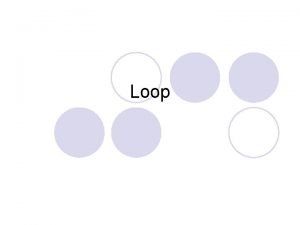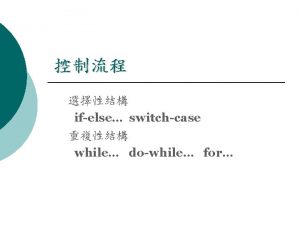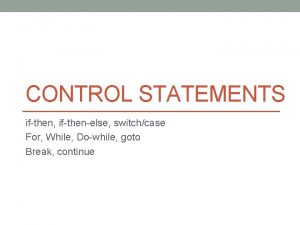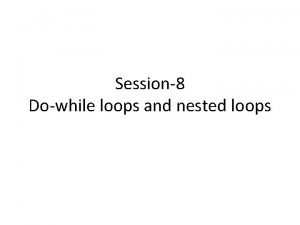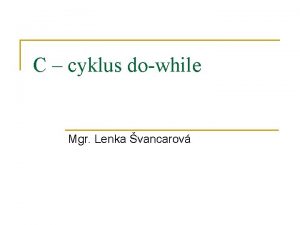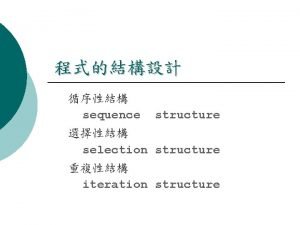ifelse switchcase while dowhile for ifelse switchcase while
















- Slides: 16

控制流程 選擇性結構 if-else… switch-case 重複性結構 while… do-while… for…

控制流程 選擇性結構 if-else… switch-case 重複性結構 while… do-while… for…

while 迴圈 ¡ syntax 1: while ( 關係運算元 ) statement ; ¡ syntax 2: while ( 關係運算元 ) { statement 1 ; . . … statement n ; }

while 範例(一) main( ) { int i=0; while ( i < 5 ) printf("%dn", i++); printf("We're out of the loop. n"); } 執行結果: 0 1 2 3 4 We're out of the loop

while 範例(二) main( ) { int i=0, c=0; while ( i < 5 ) { printf("%d", i++); printf("%dn", ++c); } printf("We're out of the loop. n"); } 執行結果: 01 12 23 34 45 We're out of the loop.

do -- while 迴圈 ¡ syntax 1: do statement ; while (關係運算元) ; ¡ syntax 2: do { statement 1 ; statement 2 ; . . . statement n ; } while (關係運算元) ;

do -- while 的範例 執行結果: main( ) 01 { 12 int i=0, c=0; 23 do { 34 printf("%d", i++); 45 printf("%dn", ++c); We're out of the loop. }while( i < 5 ); printf("We're out of the loop. n"); }



for 迴圈範例(二) 想一想: 印出來的結果為? main( ) 01 { 12 int i, c ; 23 for ( i=0, c=1 ; i < 5 ; ++i, ++c ) 34 { 45 printf("%d", i); We're out of the printf("%dn", c); } loop. printf("We're out of the loop. n"); }



隨堂練習三 試利用 for 迴圈撰寫如下九九乘法表。 1*1= 1 1*2= 2 1*3= 3 1*4= 4 1*5= 5 1*6= 6 1*7= 7 1*8= 8 1*9= 9 2*1= 2 2*2= 4 2*3= 6 2*4= 8 2*5=10 2*6=12 2*7=14 2*8=16 2*9=18 3*1= 3 3*2= 6 3*3= 9 3*4=12 3*5=15 3*6=18 3*7=21 3*8=24 3*9=27 4*1= 4 4*2= 8 4*3=12 4*4=16 4*5=20 4*6=24 4*7=28 4*8=32 4*9=36 5*1= 5 5*2=10 5*3=15 5*4=20 5*5=25 5*6=30 5*7=35 5*8=40 5*9=45 6*1= 6 6*2=12 6*3=18 6*4=24 6*5=30 6*6=36 6*7=42 6*8=48 6*9=54 7*1= 7 7*2=14 7*3=21 7*4=28 7*5=35 7*6=42 7*7=49 7*8=56 7*9=63 8*1= 8 8*2=16 8*3=24 8*4=32 8*5=40 8*6=48 8*7=56 8*8=64 8*9=72 9*1= 9 9*2=18 9*3=27 9*4=36 9*5=45 9*6=54 9*7=63 9*8=72 9*9=81

break 的用途 int main( ) { int i= 0 ; while(i <= 5) { ++i; if ( i == 3 ) break ; printf(“i=%dn”, i); } system("PAUSE"); return 0; } 結果: i=1 i=2

continue 的用途 int main( ) { int i= 0; while(i <= 5) { ++i; if ( i == 3 ) continue ; printf(“i=%dn”, i); } system("PAUSE"); return } 0; 結果: i=1 i=2 i=4 i=5 i=6

產生亂數的方法 #include <stdio. h> #include <stdlib. h> #include <time. h> int main() { int rand_num; int ……… srand((unsigned)time(NULL)); rand_num = rand() % 10 + 1; ……… //下亂數種子 //� 生介於 1~10 的亂數�
 L loop ll
L loop ll C while
C while While do loop
While do loop Tack för att ni lyssnade bild
Tack för att ni lyssnade bild Nyckelkompetenser för livslångt lärande
Nyckelkompetenser för livslångt lärande Ro i rom pax
Ro i rom pax Mästar lärling modellen
Mästar lärling modellen Shingelfrisyren
Shingelfrisyren Stål för stötfångarsystem
Stål för stötfångarsystem Centrum för kunskap och säkerhet
Centrum för kunskap och säkerhet Verktyg för automatisering av utbetalningar
Verktyg för automatisering av utbetalningar Shaktismen
Shaktismen Bo bergman jag fryser om dina händer
Bo bergman jag fryser om dina händer Inköpsprocessen steg för steg
Inköpsprocessen steg för steg Vad är hsil
Vad är hsil Strategi för svensk viltförvaltning
Strategi för svensk viltförvaltning Anatomi organ reproduksi
Anatomi organ reproduksi
